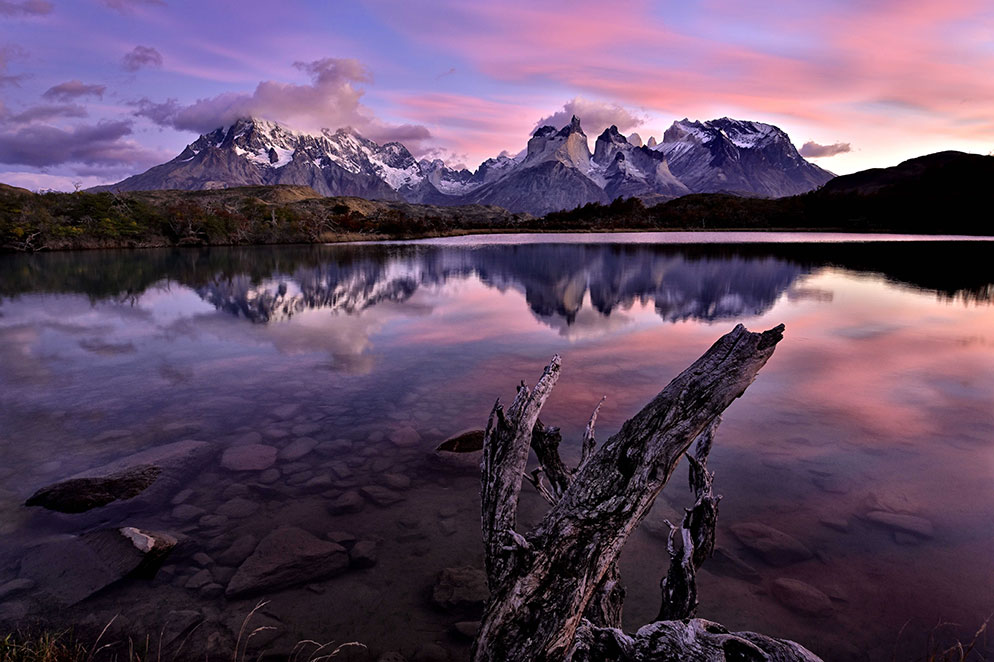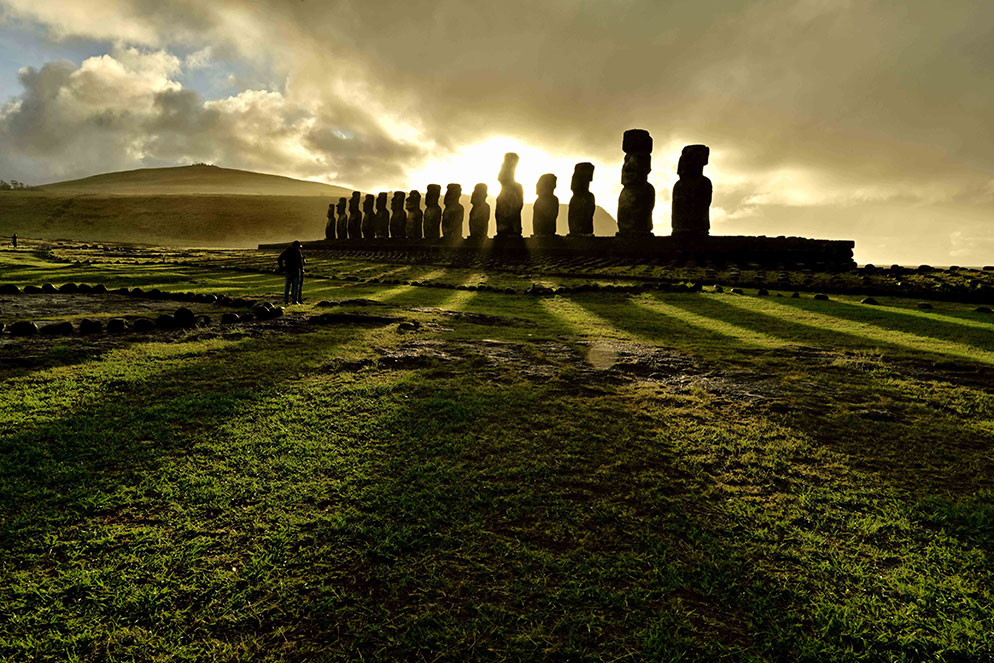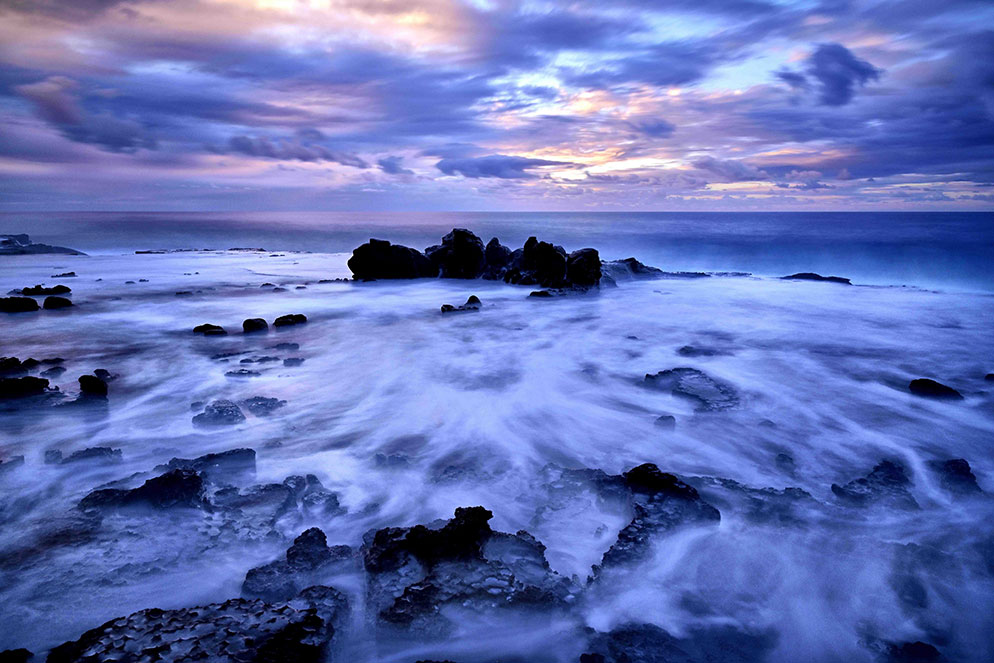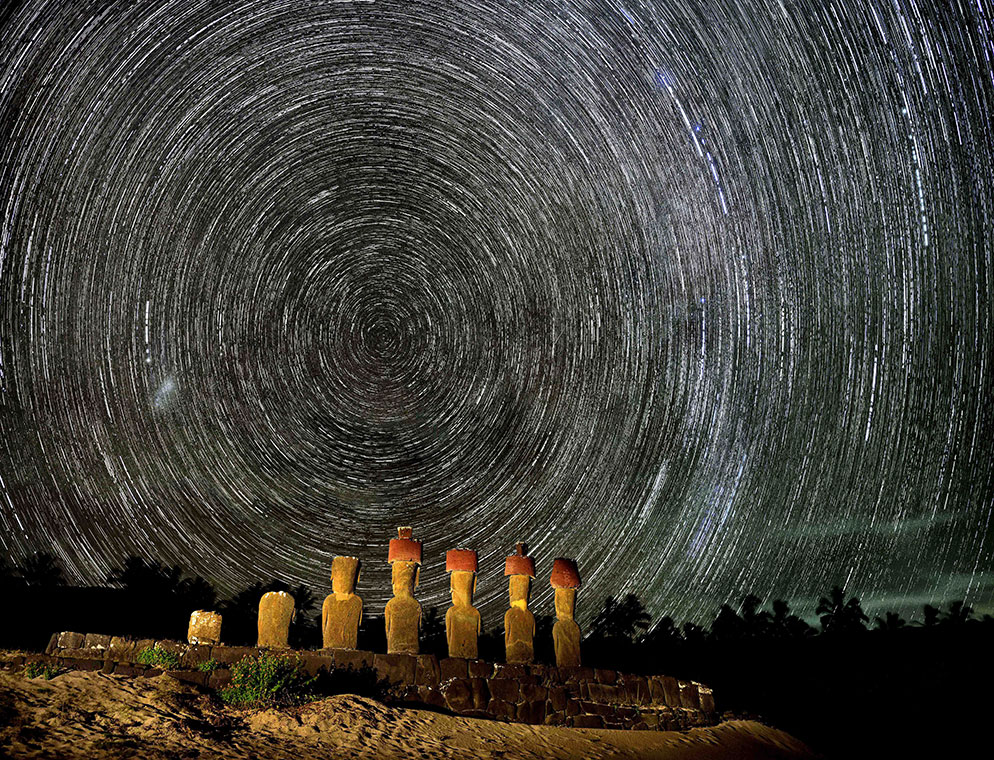Boot Camp Vacation: The Give and Take of a Photo Workshop
Sunrise casts long shadows of 15 Easter Island Moai statues. "We arrive in pitch dark, set up the tripods and photograph as it gets brighter, bit by tiny bit," Katsu says. Most photographers try to avoid having people in landscape photos, but here, for scale, Katsu included two tourists who happened to walk into the frame. "It's part of storytelling," he says. Z 7, Mount Adapter FTZ, AF-S NIKKOR 14-24mm f/2.8G ED, 1/100 second, f/16, ISO 100, aperture priority, Matrix metering.
Katsu Tanaka calls the people who take his workshop "my guests."
That's one side of the coin. The other side is that he cheerfully admits that his guests often call the workshop "photo boot camp."
The coin also has a third side: from time to time, Katsu refers to the workshop as his guests' "vacation."
All of the above is not only possible, it's true.
The guests put in long days to attain improved images. Evaluating the workshop, they comment on the beautiful and fascinating locations, the challenges they faced and the expert advice and instruction they received.
Katsu offers his Patagonia/Easter Island workshop twice a year, for groups no larger than eight guests. "That way I can pay attention to everybody's needs and to all the details," he says.
When we spoke with him, he'd held the workshops for seven years, and we asked him about his challenge: keeping it fresh for not only the guests, but for himself.
Easter Island's coastline is dotted with volcanic rock, and Katsu knows that waves crashing onto those rocks will make for dramatic pictures. As the morning started to get brighter, he put a neutral density filter on his lens to get long exposures in order to capture the movement of the water. "I got soaking wet testing out different shutter speeds and depths of field. Some my guests knew I'd get strong images, so they were standing right there with me." Z 7, NIKKOR Z 24-70mm f/2.8 S, 20 seconds, f/9, ISO 200, manual exposure, Matrix metering.
"I'm an editorial photographer," he says. "I mainly take photos for magazines and books, and I don't normally hear or see the reaction of my readers. Teaching is small scale, intense, over many days, and I see the results of my work. When [my guests] capture something they never thought they could, and their eyes sparkle and there's so much joy and excitement, and we share the experience as a group—that gives me total satisfaction."
The destinations play a part, too. Even though he is familiar with Patagonia and Easter Island—"so confident and comfortable, knowing every corner of the locations, and the meaning of the geology, history and culture"—every time he goes back he gets new and different ideas for himself and his guests.
For the most recent workshops, there's also been a relatively new camera to shoot with—the Z 7, which he's added to his D5 and D850, and which has become his go-to camera for low-light sunrises and sunsets; the vast, grand-scale landscapes of Patagonia; and the lightpainting/star trail images taken on Easter Island.
It's also the hands-down choice for the workshop's long day of hiking. He finds the lighter-weight combination of the Z 7—"a fantastic camera"—and the NIKKOR Z 24-70mm f/2.8 S "quite a bonus" for the walking and trekking that comes with the workshop's territory. "For the remote, beautiful, natural environment, I'd say about 80 percent of my shooting is with the Z 7."
An image from the star shoot on Easter Island. The camera was set for continuous release mode, manual focus and, 30-second exposures. During the first exposure, Katsu light-painted the Moai statues with "classic, old-style flashlights." After that exposure, and without changing the framing, the camera kept shooting 30-second exposures, one after the other, for an hour. About 80 images were later assembled to create the composite. Z 7, NIKKOR Z 24-70mm f/2.8 S, 30-second exposures, f/2.8, ISO 1600, manual exposure, Matrix metering.
"You Make the Decisions"
If Katsu's workshop were a car, it'd be a stick shift.
The first thing he recommends is that his guests shoot with their cameras set for manual exposure. Actually, "recommends" may not be a strong enough word. Let's say he urges them to not rely on any automatic program, not because the programs aren't reliable, but because he wants them to understand the difference their decisions make, and to see the results of those decisions in the image. His purpose is to make sure they understand that control of the camera is what creativity and expression is all about.
He says it's tough for the guests in the beginning—even for the advanced photographers who, he finds, tend not to use manual mode—but he feels they should learn how to control all the elements of the exposure. He gets them to use manual for almost the whole workshop. "They end up loving it," he says, "because they learn to think in every situation, for every frame."
When [my guests] capture something they never thought they could...and we share the experience as a group—that gives me total satisfaction.
Sunrise in Torres del Paine National Park, Patagonia. The workshop guests stay in a hotel that fronts onto the lake. "Every morning we step outside to practice our sunrise shoot," Katsu says. "You can see why I urge everybody to wake up early and come out in the dark. This was a beautiful morning for the shoot—there was zero wind, which is rare, and that's why there's a perfect reflection." Z 7, Mount Adapter FTZ, AF-S NIKKOR 14-24mm f/2.8G ED, 0.4 seconds, f/8, ISO 100, manual exposure, Matrix metering.
The Boot Camp Aspect
Start with the Patagonian terrain—it can be tough, there's long days of work and some trekking, and there's often rain and almost always wind.
And the guests are always on the go. They're up early for sunrise shoots, and after a day of shooting they return to an (admittedly beautiful) resort hotel where they download all their images (they can easily shoot 500, sometimes 1,000 each day), back up everything then select three to five favorites to submit for the evening's critique session, which takes place after dinner.
"I do the critique every night," Katsu says. "We have the ability to show the images on a big screen, and I do an hour- to an hour-and-a-half session with them, going through the photos they selected." It all makes for a very long day, which probably accounts for the "photography boot camp" tag.
Still, it is also something of a vacation: they're away from their normal routines, among like-minded people, with a skilled instructor, amid beautiful landscapes. "And I do tell them they don't have to get up early everyday for the sunrise photography," Katsu says. "They can skip any part of it—'It's your vacation,' I say. But though sleep time is short—especially on Easter Island with the night shoots—none of them skip any of it."
Certainly not the critique session. "It's the most fun, but at first they are a little bit overwhelmed and a little shy, but they soon realize it's not a competition—they see that they are very different from each other."
Katsu took this image of Torres del Paine from his room in the hotel. "The weather in Patagonia changes almost every minute—it pours rain, then the next moment, there's blue sky; then snow a moment later. We call it 'the four seasons in a day,' and it's all because of the wind. Sometimes when we wake up and it's pouring rain, so all you can do is wait and from your room take the picture that the next moment's weather you—which is what happened here." Z 7, NIKKOR Z 24-70mm f/2.8 S, 0.6 seconds, f/11, ISO 64, manual exposure, Matrix metering.
The Vertical Curve
Katsu has seen over the years a pattern in how his guests learn and apply what they've learned—and not only a pattern, but a pace.
"In a short time they start to see things quite differently," he says, and they become critical of their own work. Then the improvements come quickly.
"It is not gradual, it's kind of like a skyrocketing curve. For the first couple of days they struggle with the manual settings or the environment—shooting in the extreme wind of Patagonia is something they've never experienced. And I keep talking to them: shoot, shoot, change the setting, the bracketing, your white balance. So in the beginning they might be really confused, but after three or four days they get the rhythm and the routine of the shoot, and [the] learning curve skyrockets."
Katsu finds beginners the easiest ones to teach, the quickest to absorb what he's telling them. It might be because there are few bad habits, or none at all, to unlearn. "The more advanced photographers are the tougher ones when it comes to adjusting to new ideas," he says. "The novice people, they do as I say, and they immediately understand what it means [because] they see the immediate result of every change of a camera setting. That's the beauty of digital—they pick up things really quick."
What he hopes, of course, is that soon they will move beyond his interpretation of how a scene should be captured and find their own direction. He wants them to leave the workshop with beautiful photographs, but his ultimate goal is that they understand how those photos were made; that they've learned about their cameras, about photography and about themselves; that they've learned to tell not his stories, but their own.
That's yet another side of the coin.










